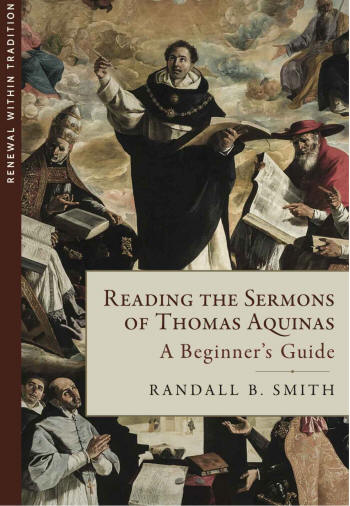Book Review
Reading The Sermons Of Thomas Aquinas
A Beginners Guide
Randall B. Smith
Emmaus Academic ( 1 Nov 2016)
ISBN:
978-1941447970
 This
proved to be a wonderful read. Thomas was a great theologian and
philosopher. But, being a Dominican, he was a preacher as well. However,
as the author shows us, when he preached on Scripture, it is in a manner
that is somewhat removed from current practice. This is because Thomas is
not really preaching on the text as such but is forming us in our faith.
We have to remember that medieval culture was primarily memorial: few
people were rich enough to possess books. And so, it is hardly surprising
to learn that Thomas employed the mnemonic method to help his listeners
learn their faith in his sermons.
This
proved to be a wonderful read. Thomas was a great theologian and
philosopher. But, being a Dominican, he was a preacher as well. However,
as the author shows us, when he preached on Scripture, it is in a manner
that is somewhat removed from current practice. This is because Thomas is
not really preaching on the text as such but is forming us in our faith.
We have to remember that medieval culture was primarily memorial: few
people were rich enough to possess books. And so, it is hardly surprising
to learn that Thomas employed the mnemonic method to help his listeners
learn their faith in his sermons.
An Advent sermon is based on the text from St Matthew's Gospel: "Behold, your king comes to you, meek, and riding on a donkey." From the word "Behold", Thomas is able to present the fourfold meaning of Christ's Advent: in his Incarnation, in the way he enters the mind of believers, at the moment of our death and at the end of time. A meditation on the word "comes" is about the benefits of Christ's coming: to reveal the Divine Majesty, to reconcile us to God, to free us from sins and to give us eternal life.
So we see that the words "Behold" and "comes" are being used as a mnemonic device by Thomas. And each word is used in order to draw out the themes he intends to treat. What does it mean to call Christ "King"? A king symbolizes unity, fullness of power, abundant jurisdiction over the kings of this world, and the one who brings equity in justice. As he symbolizes unity, all heresy which divides must be rejected. As he has fullness of power, so he has authority over the law. As he has abundance of jurisdiction, he has authority over the kings of this world. And as he brings equity in justice, so he orders all things to the common good. From what Thomas tells us, it is easy to see how we end up with a feast of Christ The King.
And all this from one word! With a little training, his listeners would have been able to remember the sermons of St Thomas from a single word.
There is certainly an oddness about the way Thomas preaches. For example, something from the life of St Nicholas of Myra is found, according to Thomas, in an Old Testament reading. That is surely somewhat far-fetched. And yet, says the author, the very oddness of the presentation helps us recall the sermon. The people then had greater powers of recollection than us today and this applies above all to Thomas himself: witness the profundity and length of his works.
We need an interpretive key in order to understand and benefit from the sermons of St Thomas. This book serves precisely that purpose.
Reviewed by Dr Pravin Thevathasan
